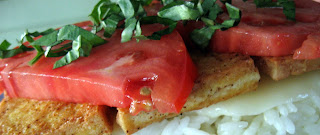
So, the
Enterprise CSA sent us this
beautiful white eggplant. It was literally unlike any eggplant we had ever seen before. (I've never seen one like it in a store. That's why I love getting a CSA.)
This eggplant demanded special attention. We had to
respect its gravitas. It simply would not do to give it our usual treatment, dicing it into small pieces and stir-frying it into that co-op favorite, veggie slop. This eggplant wanted to be
made into quails. (Well, maybe, but that's not what we wanted for dinner.)
This eggplant deserved the full-court press, four chefs in the kitchen, every burner in service treatment. This eggplant wanted to dirty every pan we owned in its preparation. (This eggplant, as you will notice from our narrative, did not, however, quite merit a special trip to the grocery store for ingredients.)
This eggplant was going to be made into lasagna.
Jack sliced, breaded, and fried the eggplant. (When we later admired its firmness of texture, reminiscent almost of fried fish, he acknowledged, "that could be because I used fish seasoning.")
Meanwhile, I sliced the tomatoes, boiled the lasagna noodles (it turned out we had only four, so they were more of a gesture toward tradition than an ingredient), and sliced and sauteed a box of button mushrooms we'd inherited (thanks, Ariel!).
Liz prepared the cheese, which was a challenge only because we didn't have anything like the cheese you would want to have if you had, say, planned in advance to make lasagna. Jack instructed her to make "something like ricotta," and bless her, she made a medley of yogurt and sour cream and the bits and ends of several items from our cheese drawer that was something like ricotta. (Note for posterity: a little bit of smoked cheddar is lovely in an eggplant lasagna.)
Jack seared the tomato slices, because, honestly, that man will
put anything in a frying pan if you don't watch him. (I caught him frying dried mint leaves today, but that's a different story for a different blog post.) While defending his gorgeous stack of fried eggplant from our attempts to nibble, nay devour it. (It was that good. Oh, it was so good. A little fried eggplant would hit the spot right about now, actually.)
Erica washed our never-ending stream of pots and spoons and dishes like the
kitchen hero she is.
Liz layered it up: pasta sauce, lasagna noodles, cheese mixture, fried eggplant, sauteed mushrooms, seared tomatoes, basil, rinse, repeat, and grated Parmesan on top. Everything was cooked, but we put the lasagna in the oven for 20 minutes to warm it through and melt the cheese and just because we like dying of slow torture by hunger every now and again.
Turns out, it was lasagna worth waiting for.

And the eggplant? Delicious. To die for.
Every complaint anyone
has ever had about eggplant was resolved here. It was not bitter. It was not mushy. It was firm-but-tender, delectable, mild-tasting, non-slimy eggplant. It was eggplant even a nonvegetarian could love.
(P.S. Dear Enterprise Farm, please send us some more of those white eggplants!)










































